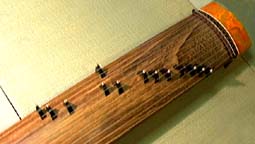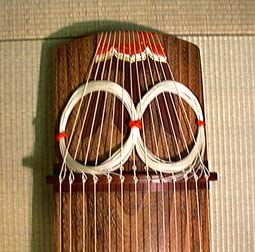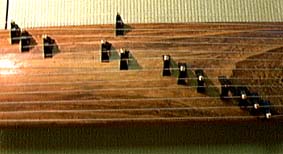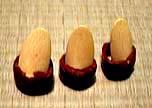A Look at the Koto
|
The names for the parts of a koto were decided long ago by likening the instrument to a dragon stretched out along the ground. Some of the parts' names are written with Chinese characters meaning "dragon's tongue," "dragon's brow," and "dragon's horn."
This section is the main body of the koto. The musician plucks the strings with the right hand, being sure to touch them on the right of the ji, the supports under the strings.
After the koto is strung, and the strings are run through holes in the instrument's body and tied off, the leftover string is placed here. It's coiled into two bunches--one of six strings and one of seven--and kept in case a string breaks later.
These supports are slid up and down the instrument to adjust the sound of each string. With their notched tops to hold the strings, they also help transmit the sound from the strings to the body of the koto, making it fuller and richer.
The koto is not played directly with the fingers. Instead, the musician puts three tsume on the index finger, middle finger, and thumb of the right hand and plucks the strings with them.
|
|
|
 Ryuko (dragon's back)
Ryuko (dragon's back) Ryubi (dragon's tail)
Ryubi (dragon's tail) Ji (bridges)
Ji (bridges) Tsume (claws)
Tsume (claws)

